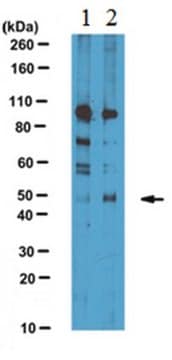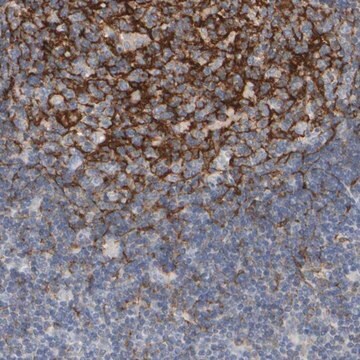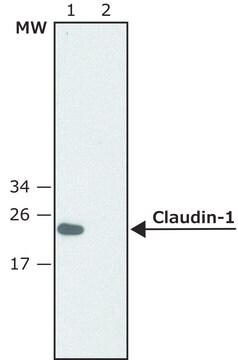일반 설명
We are committed to bringing you greener alternative products, which adhere to one or more of The 12 Principles of Green Chemistry.This antibody is Preservative-free, produced without the harm or sacrifice of animals and exceptionally stable to allow for ambient shipping and storage if needed and thus aligns with "Waste Prevention", "Designing Safer Chemicals" and "Design for Energy Efficiency".
Click here for more information.
ZooMAb® antibodies represent an entirely new generation of recombinant monoclonal antibodies.
Each ZooMAb® antibody is manufactured using our proprietary recombinant expression system, purified to homogeneity, and precisely dispensed to produce robust and highly reproducible lot-to-lot consistency. Only top-performing clones are released for use by researchers. Each antibody is validated for high specificity and affinity across multiple applications, including its most commonly used application. ZooMAb® antibodies are reliably available and ready to ship when you need them.
특이성
Clone1B21 is a ZooMAb® Rabbit recombinant monoclonal antibody that specifically detects ATF4. It targets an epitope within 22 amino acids from the C-terminal region.
면역원
KLH-conjugated linear peptide corresponding to 22 amino acids from the C-terminal region of human ATF-4.
애플리케이션
Quality Control Testing
Evaluated by Western Blotting in HeLa treated with Tunicamycin.
Western Blotting Analysis: A 1:1,000 dilution of this antibody detected ATF4 in lysate from HeLa cells overnight starved and treated with Tunicamycin (5 μg/mL; 6 h).
Tested applications
Affinity Binding Assay: A representative lot of this antibody bound ATF4 with a KD of 1.1 x 10-8 in an affinity binding assay.
Immunocytochemistry Analysis: A 1:100 dilution from a representative lot detected ATF4 in HeLa cells treated with tunicamycin.
Note: Actual optimal working dilutions must be determined by end user as specimens, and experimental conditions may vary with the end user
표적 설명
Cyclic AMP-dependent transcription factor ATF-4 (UniProt: P18848; also known as cAMP-dependent transcription factor ATF-4, Activating transcription factor 4, Cyclic AMP-responsive element-binding protein 2, CREB-2, cAMP-responsive element-binding protein 2, Tax-responsive enhancer element-binding protein 67, TaxREB67, ATF4) is encoded by the ATF4 (also known as CREB2, TXREB) gene (Gene ID: 468) in human. ATF4 is a transcription factor that binds the cAMP response element (consensus: 5′-GTGACGT[AC][AG]-3′) as a homodimer or heterodimer and regulates metabolic and redox processes under normal conditions and as a master transcription factor under integrated stress response (ISR). It is shown to be essential for adaptation to ER stress, amino acid starvation, and oxidative stress. In response to ER stress and amino acid deprivation, ATF4 activates transcription of asparagine synthetase. It is also reported to activate the transcription of NLRP1 in response to ER stress. The N-terminal region of ATF4 contains a p300/CBP associated factor (PCAF) domain for p300 interaction, a leucine zing finger region II for the binding of neuronal cell death putative kinase, and a prolyl-4 hydroxylase domain. The leucine zipper is required for the dimerization of two DNA binding regions and for recognition of 5 -TGACGTCA-3 DNA sequence within promoters. It has two other domains, the oxygen dependent degradation (ODDD) domain and βTrCP motif that are reported to be involved in ATF4 degradation. At its C-terminal region, it contains the basic/leucine zipper domain (bZIP domain) that serves as a DNA binding sequence for interaction with Abro1, EBPβ, FIAT, SATB2, and death-associated protein Ser/Thr kinase 3 (DAPK3). This ZooMAb® recombinant monoclonal antibody, generated by our propriety technology, offers significantly enhanced specificity, affinity, reproducibility, and stability over conventional monoclonals. (Ref.: Guo, X., et al. (2020). Nature. 579(7799); 427-432; Pitale, PM., et al. (2017). Front. Cell. Neurosci. 11; 410; Siu, F., et al (2002). J. Biol. Chem. 277(27); 24120-24127).
물리적 형태
Purified recombinant rabbit monoclonal antibody IgG, lyophilized in PBS, 5% Trehalose, normal appearance a coarse or translucent resin. The PBS/trehalose components in the ZooMAb formulation can have the appearance of a semi-solid (bead like gel) after lyophilization. This is a normal phenomenon. Please follow the recommended reconstitution procedure in the data sheet to dissolve the semi-solid, bead-like, gel-appearing material. The resulting antibody solution is completely stable and functional as proven by full functional testing. Contains no biocide or preservatives, such as azide, or any animal by-products. Larger pack sizes provided as multiples of 25 μL.
재구성
300 μg/mL after reconstitution at 25 μL per vial. Please refer to guidance on suggested starting dilutions and/or titers per application and sample type.
저장 및 안정성
Recommend storage of lyophilized product at 2-8°C; Before reconstitution, micro-centrifuge vials briefly to spin down material to bottom of the vial; Reconstitute each vial by adding 25 μL of filtered lab grade water or PBS; Reconstituted antibodies can be stored at 2-8°C, or -20°C for long term storage. Avoid repeated freeze-thaws.
법적 정보
ZooMAb is a registered trademark of Merck KGaA, Darmstadt, Germany
면책조항
Unless otherwise stated in our catalog or other company documentation accompanying the product(s), our products are intended for research use only and are not to be used for any other purpose, which includes but is not limited to, unauthorized commercial uses, in vitro diagnostic uses, ex vivo or in vivo therapeutic uses or any type of consumption or application to humans or animals.








